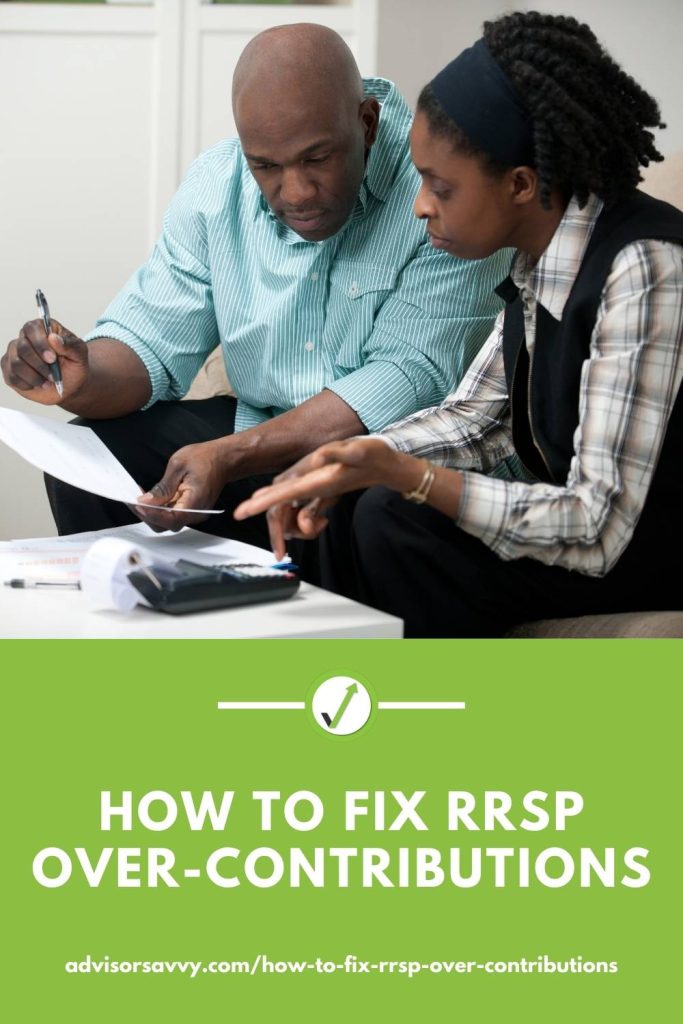
A Registered Retirement Savings Plan (RRSP) is one of the best ways of saving for retirement. It offers so many long- and short-term benefits. It’s important, however, to understand exactly how much contribution room you have in any given year. Why? When you over-contribute, you pay a penalty. No one wants that! But the good news is that you can fix RRSP over-contributions.

Table of contents
- What is an RRSP?
- The benefits of making RRSP contributions
- How do contributions to an RRSP work?
- How much can I contribute to an RRSP?
- How can I make sure I don’t over-contribute to my RRSP?
- What is the deadline for RRSP contributions?
- What happens if I have RRSP over-contributions?
- How do I determine if I have over-contributed to an RRSP?
- How to fix RRSP over-contributions
- Three ways of fixing RRSP over-contributions
- RRSPs and Over-Contributions
In this article, find out how to fix over-contributions, and get answers to some of the most commonly asked questions about RRSPs. For example: What exactly is an RRSP, and what is it used for? How do you know how much to invest, and where? And what happens if you over-contribute to an RRSP?
What is an RRSP?
An RRSP is a registered savings account designed to help Canadians save money for retirement. Contributions to RRSPs are protected from income tax, and you can hold a variety of investments within your account. In addition, any funds earned through these investments are protected from tax for as long as they remain invested. As a result, your portfolio can grow in time to retire comfortably.
To maximize this benefit, it’s important to not over-contribute to an RRSP in the first place. Otherwise, you have to either fix it or pay a penalty.
FYI: Want to know at what age you can retire? Try our Age Retirement Calculator
The benefits of making RRSP contributions
The best advice is to invest in an RRSP as early and as soon as possible. It’s one of the best ways (and most common) of ensuring a comfortable retirement. RRSPs also offer additional, short-term benefits — as long as you don’t over-contribute, of course.
Your investments in an RRSP are untaxed. Therefore, at income tax time, you lower your income by the amount of total contributions to your RRSP. This ultimately lowers the amount of tax you owe to the government for that tax year.
Keep in mind: you pay income tax when you withdraw money from your RRSP. One of the biggest RRSP guidelines to remember is that if you don’t need to access it until you retire, don’t. Income is traditionally lower in retirement, and a lower income means a smaller tax hit on withdrawals.
How do contributions to an RRSP work?
You invest in RRSPs throughout your working life. The government sets annual contribution limits, but the intention is to leave that money alone until retirement — when you have a drop in income (and also, likely, fewer expenses).
As mentioned above, money that goes into an RRSP is tax-deferred, meaning it’ll lower your taxes when you make more money. In addition, when you eventually withdraw from it in retirement, you are charged a lower tax rate because you’re making less.
How much can I contribute to an RRSP?
Unfortunately, RRSPs do not have unlimited contribution room. There is a threshold of how much you can contribute. Learn more below.
Maximum RRSP contribution limit for 2021 to 2023
The first step to ensuring you don’t over-contribute to an RRSP is understanding your maximum RRSP contribution limit. The maximum amount you contribute in any given year changes based on current government regulations and your previous year’s earnings and contributions. You may also carry over contribution room from previous years. But again, it’s important to know this number so you don’t have to fix RRSP over-contributions down the road.
For the 2021 tax year, your RRSP contribution limit is 18% of the reported income on your tax return in the previous year, up to a maximum of $27,830. In the 2022 tax year, that maximum increases to $29,210. For 2023, it’s $30,780. (See amounts from previous years here).
Avoid having to fix RRSP over-contributions by estimating your limit with the help of an RRSP calculator.
How can I make sure I don’t over-contribute to my RRSP?
While there are ways to fix an over-contribution to an RRSP, it’s a better strategy to first figure out your personal contribution limit. And there are a number of ways to do that.
How to find your personal RRSP contribution limit:
- On line A of your previous year’s Notice of Assessment (NOA)
- Log into your CRA My Account
- Call the CRA’s Tax Information Phone Service (TIPS)
- On Form T1028, which you receive when your RRSP tax deduction limit changes from your last assessment.
What is the deadline for RRSP contributions?
To get the maximum benefit from your contributions (and to avoid having to fix RRSP over-contributions) it’s important to take note of the deadline for RRSP contributions. This deadline is March 1 of the next calendar year. Contributions made during the calendar year go into your tax form differently than those made between January 1 and March 1. However, it is all applied towards RRSP contributions for the previous tax year. To demonstrate, for 2023, the deadline to contribute to your RRSP and claim it on your 2023 return will be March 1, 2024.
It’s also important to factor in RRSP contributions to your overall budget planning.
What happens if I have RRSP over-contributions?
With RRSPs, you can exceed your contribution limit by $2,000 without penalty. However, after that, you no longer benefit from any further tax deduction. In addition, you pay a 1% penalty tax for every month you are over your limit. Instead, withdraw the money and wait until the next tax year to benefit from that contribution.
It’s great to be enthusiastic about saving for retirement — especially if you have extra income to really boost your savings. But it’s always helpful to avoid a situation where you have to scramble to make a change.
How do I determine if I have over-contributed to an RRSP?
To check whether you have over-contributed to an RRSP, log into your CRA account and click on your Notice of Assessment (NOA). If you’re over, there is a tax on excess contributions.
To determine the exact amount of your over-contribution, look at your NOA from the previous year and review your contribution limit. Review your contribution from the current tax year and deduct your limit. The difference is your RRSP over-contribution.
How to fix RRSP over-contributions
One way to fix over-contributions is by removing the excess funds as quickly as possible, and place them in a Tax-Free Savings Account (TFSA) — keeping in mind that TFSAs also come with limits. That way, the money still has the potential to work for you and earn money, while not being easily accessible. However, there are other ways you can fix an over-contribution.
Three ways of fixing RRSP over-contributions
- Withdraw the amount. Carrying over from the above advice, once you take out the excess amount, request the government refund your penalty. You’ll need to contact the CRA and prove you removed money and reassigned it to another savings tool. In addition, you need to prove the overpayment was unintended, and therefore you can’t be held liable for the penalty implication.
- Pay the penalty. This sounds simple, however, it actually involves a little legwork on your behalf. To pay the penalty, go back into your CRA My Account portal and review your recent NOA to determine your actual overpayment. Review your allowance from the year previous. Fill out a T1-OVP, Individual Tax Return for RRSP, PRPP and SPP Excess Contributions form and pay the 1% tax penalty.
- Prove you have the contribution room. The CRA allows you to carry over unused contribution room from previous years. So, if you do not take full advantage of your RRSP contribution allowance, provide that evidence to the CRA. Show that your allowance is greater than the limit indicated on NOA from the previous tax year.
RRSPs and Over-Contributions
RRSPs are a powerful retirement savings tool. However, it’s important to understand how much you can contribute in any given year. It’s the best way to ensure you don’t get dinged for an RRSP overpayment. And while there are ways to fix over-contributions to an RRSP, it’s best to avoid it happening in the first place. If it does? Despite some legwork needed, it’s totally fixable. And, as always, if you have questions about RRSPs, contributions, or saving for retirement, speak to a financial advisor.
Read More: TFSA vs RRSP: Where to Put Your Money
